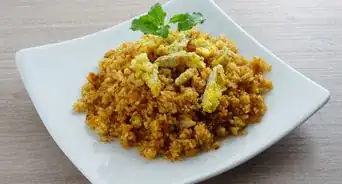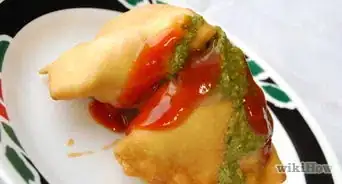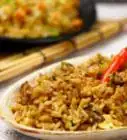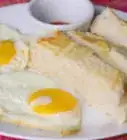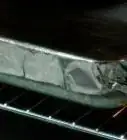This article was co-authored by wikiHow Staff. Our trained team of editors and researchers validate articles for accuracy and comprehensiveness. wikiHow's Content Management Team carefully monitors the work from our editorial staff to ensure that each article is backed by trusted research and meets our high quality standards.
wikiHow marks an article as reader-approved once it receives enough positive feedback. This article received 11 testimonials and 87% of readers who voted found it helpful, earning it our reader-approved status.
This article has been viewed 445,907 times.
Learn more...
Poha is a simple but hearty breakfast and brunch dish that originated in Northern India. Also known as aloo poha, it is made of pressed rice, potatoes, onions, and spices and is a quick and easy meal to whip up once you have all the ingredients. Poha is the Maharashtrian word for flattened rice, which you may only be able to find it at specialty Indian grocers.
This recipe is for a main course, and it serves 4.
Ingredients
- 1 tbsp peanut, canola, or vegetable oil
- 2-3 cups poha (flattened or beaten rice, dry)
- 1/2 tsp sugar
- 1 tsp mustard seeds
- 1-2 green chilies, more if you prefer spicier food
- 1 onion (small dice)
- 1 cup potato, diced (red, Yukon gold, eastern white)
- 1/2 cup peanuts (may substitute cashews)
- 3/4 tsp turmeric
- 4 curry leaves
- Salt to taste[1]
Optional
- 1/2 cup fresh cilantro (chopped) for garnish
- Fresh lemon (to squeeze at end)
- 1/2 cup grated coconut
- A pinch asafoetida
Steps
Making Breakfast Poha
-
1Rinse 2-3 cups of poha in water and let it soak for 3-4 minutes. When the poha can be lightly mashed between your fingers, it is ready. There is no need to soak it for a long time. Soaking the rice now makes it tender when you cook it later.
-
2Cook one cup of diced potatoes for two minutes in the microwave. This will partially cook the inside of the potatoes, as they take a long time to cook in the oil by themselves. Your potatoes should be roughly 1/2-inch cubes.[2]Advertisement
-
3Drain the water from the rice. In a fine mesh colander, drain the water and press the poha lightly with your fingers to get out any excess water. Transfer it to a bowl when you are done and set it aside to use later.[3]
-
4Heat 1 tsp of oil on medium in a large wok or saucepan. If you have a wok, use that. However, a normal saucepan will work fine as a substitute.
- The pan will be lightly smoking when it is hot enough, as if small bits of steam were coming off the surface.
-
5Add 1 tsp mustard seeds to the oil until the crackle. The seeds will start to dance and hiss, usually after 25-30 seconds. Once they've started to crackle a bit you can move on to other ingredients.
- If you do not have a microwave, add the potatoes now.
- If you are adding a pinch of asafoetida to the recipe, add it now.
-
6Add the diced onions, green chilies, and partially cooked potato. Chop up a small onion and 1-2 green chilies and throw them in the pan, along with the potatoes from the microwave. Stir well and let them cook for two or three minutes. The onions should be translucent (mostly clear) when you are done.
-
7Add the four curry leaves, spices, 1/2 cup peanuts, and 1/2 tsp sugar. Add everything except the cilantro and lemon to the wok and stir together. Let them cook, well mixed, for a minute or two. Make sure the potatoes are completely cooked before moving on -- you should be able to easily pierce an entire potato chunk with a fork or toothpick.
- For spices, start with a pinch of salt, 3/4 tsp turmeric, and curry powder, garam masala, chile powder, and/or garlic powder to taste.
-
8Add the rice and stir well. Mix everything into the poha and lower the heat to medium-low. Keep cooking everything together until the poha is hot and ready to serve.
-
9Garnish with cilantro and lemon juice and serve hot. While optional, lemon and cilantro will give a nice fresh burst of flavor at the end of the dish.
Variations
-
1Know that poha is a very customizable, versatile recipe. Because of its relative simplicity, there is a lot you can add to poha to suit your tastes. Some additional spices to consider alongside the onions include:
- 3 pods green cardamom
- 1 tsp ground or freshly cut ginger
- 1/2 tsp chili powder
- A pinch asafoetida (found at Indian grocer)
- 1/2 tsp garam masala[4]
-
2Fry the potatoes ahead of time to make "batata poha." This recipe gets a light, crispy texture to the potatoes that matches well with the peanuts. Use an extra 1/2 tb of oil and fry the potatoes in the oil before they are a light golden color on the outside, then add the mustard seed and continue with the recipe.
- Do not fully cook the potatoes before continuing -- they will continue to cook with the onions and spices.[5]
-
3Add 1/2 cup cooked chickpeas, or chana for a heartier poha. Chickpeas, known as "chana" in Indian cuisine, can go in right before the onions, getting a nice golden brown outside in the final dish. For some people, chana is essential to a good poha recipe.[6]
-
4Try adding 1 cup of green peas for a more vegetable-based Poha. Though not in many traditional poha recipes, modern chefs have begun to incorporate a variety of vegetables from around the world into poha with wonderful results. The light sweetness and quick cooking time of green peas make them perfect for poha.[7]
- Try adding 1/2 cup of chopped tomatoes right before serving as well.
-
5Serve with a little bit of yogurt to counteract the spicy kick of hot poha. This little breakfast tip is a perfect pairing of savory and spicy. Add a scoop of plain yogurt your bowl right before serving if you think it is too hot, or if you want a little tangy flavor in the poha.[8]
Community Q&A
-
QuestionIs poha good for diabetics?
 Community AnswerRemember that poha is rice, and rice contains sugar and carbs. So diabetics may eat it, but in limited amounts.
Community AnswerRemember that poha is rice, and rice contains sugar and carbs. So diabetics may eat it, but in limited amounts. -
QuestionCan we make poha without mustard seeds?
 Community AnswerYou can certainly. What matters in poha is taste, which mustard can help with.
Community AnswerYou can certainly. What matters in poha is taste, which mustard can help with. -
QuestionWhen the poha is made from rice, the water is drained out. Will that cut the sugar and carbohydrates?
 Community AnswerNo, draining the water won't change the amount of sugar and carbohydrates in the rice.
Community AnswerNo, draining the water won't change the amount of sugar and carbohydrates in the rice.
Warnings
- This dish cooks quickly, so stay at the stove to make sure nothing burns. Lower the heat if things start cooking too quickly.⧼thumbs_response⧽
References
- ↑ http://www.thekitchn.com/recipe-breakfast-poha-47062
- ↑ http://www.thekitchn.com/recipe-breakfast-poha-47062
- ↑ http://www.vahrehvah.com/poha-upma
- ↑ http://www.manjulaskitchen.com/2011/03/21/poha-or-chudway-flattened-rice/
- ↑ http://www.vegrecipesofindia.com/potato-poha-recipe-batata-poha-potato-poha/
- ↑ http://www.vahrehvah.com/poha-upma
- ↑ http://www.manjulaskitchen.com/2011/03/21/poha-or-chudway-flattened-rice/
- ↑ http://www.vahrehvah.com/poha-upma
About This Article
To make poha, soak 2-3 cups of poha for 3-4 minutes, then drain it through a fine mesh colander. Next, dice the potatoes and microwave them for 2 minutes. Then, heat the oil in a large wok or saucepan, add the diced onions, green chilies, and potatoes, and saute them for 1-2 minutes. Add the poha, mix the ingredients thoroughly, and cook the dish over low heat until the poha is heated through. Garnish the poha with cilantro and lemon juice and enjoy! For tips about yummy variations you can try, read on!
-Step-1-Version-2.webp)
-Step-2-Version-2.webp)
-Step-3-Version-2.webp)
-Step-4-Version-2.webp)
-Step-5-Version-2.webp)
-Step-6-Version-2.webp)
-Step-7-Version-2.webp)
-Step-8-Version-2.webp)
-Step-9-Version-2.webp)
-Step-10-Version-2.webp)
-Step-11.webp)
-Step-12.webp)
-Step-13.webp)
-Step-14.webp)

